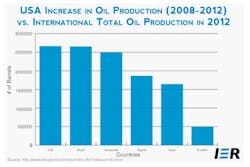The energy portion of electronics distributor TTI’s industrial business has been a bright spot on the economic horizon and is likely to continue on that path, according to Lew LaFornara, vice president of supplier relations for the company. Industrial markets have been a mixed bag recently, he explains. But with an increase in domestic oil and gas exploration and new production techniques causing growth in both areas, companies selling to those customers are seeing steady increases.
Indeed, domestic oil and natural gas production is on the rise, causing many suppliers to sharpen their focus on traditional energy markets. Shale oil production in particular is set to jump by nearly a third this year to 3.3 million barrels a day, largely due to new extraction techniques that are changing the industry. Economist Jack Ablin, who spoke to distributors and manufacturers at the recent ECIA Executive Conference in Chicago, pointed to the growth as a key positive sign on the economic landscape.
“We are moving toward energy independence,” Ablin said, pointing to new hydraulic fracturing, or “fracking,” techniques many U.S. companies are using to reach areas previously unable to be drilled. “U.S. domestic production of crude oil and natural gas is rising. And innovation in the private sector is leading the way.”
Combined with ongoing efforts aimed at energy efficiency in both consumer and industrial circles, energy-focused distributors are betting on such innovations to drive growth into 2014.
Focusing On Oil And Gas
In the past four years, U.S. oil and natural gas production has increased by nearly 2.7 million barrels per day—to more than 11 million barrels per day—according to the Institute for Energy Research (IER), which calls the recent growth “impressive.” In a report published earlier this year, IER said the increase alone equates to more oil than the total production of countries such as Brazil, Venezuela, Algeria, or Qatar (see the figure).
American companies that supply the oil and gas industry are taking note. A recent announcement by electronics distributor PEI-Genesis is a case in point. This summer, the connector and power supplies specialist created a new position aimed at growing its energy-related business, naming Mike Brawner oil and gas business development manager for North America. PEI-Genesis says the new position will help expand its work with harsh-environment and explosion-proof connector brands as well as its proprietary explosion-proof cable assemblies.
“This new role is strategic to the long-term development and growth of the North American oil & gas market,” Dave Jones, director of global sales at PEI-Genesis, said in a statement announcing the change in August. “Based in our Houston office, Mike will be local to our customers and suppliers to help us develop the rest of the Gulf region. His in-depth knowledge of this region, our products, services, and the general challenges our customers in this market face daily makes him a perfect fit for the role. We look forward to his valuable input in the further development of our oil & gas offerings.”
As further evidence of energy market growth, Ablin pointed to the increase in natural-gas powered vehicles during the recent ECIA conference. Nationwide, more trucking companies and shuttle bus providers are turning to natural-gas powered vehicles, he said. This fall, for example, logistics provider UPS expanded its use of natural gas-powered vehicles with a deal to purchase liquefied natural gas (LNG) fuel from an Indiana startup company to power 1000 of its semitrailer trucks in use throughout the Midwest. UPS has used LNG fuel in its fleet since 2000 and added 48 new LNG trucks to its long-haul network just two years ago.
Efficiency Remains A Priority
Conservation and energy efficiency continue to drive strength in the energy sector as well, and many distributors point to consumer and industrial demand for energy-efficient lighting solutions and technology related to smart homes and business as key growth areas.
“I don’t know of a company today in any industry that isn’t focused on conserving energy,” says Lindsley Ruth, executive vice president of distributor Future Electronics.
As an example, he notes the large amount of energy consumed in electronics, which causes a long-term focus on energy reduction and efficiency among component makers and distributors. A key market is lighting, where a shift continues from traditional sources to LED technology. Also growing in importance are devices focused on smart homes and offices. Technologies that help homeowners control heating, air conditioning, electricity, and security systems remotely, for example, are increasingly in demand.
Another way to conserve energy is through the use of wireless technology and extended battery life. Ruth calls this “a tremendous challenge and opportunity within the electronics space.”
Future has developed targeted efforts to serve both markets. Its Future Energy Solutions and Future Lighting Solutions groups provide sales and service resources specifically for those markets. Looking at lighting in particular, FLS has grown to 452 employees and is expected to exceed $2 billion in sales in the next two to three years, Ruth says.
“[The lighting market] is just so fast-paced,” he says.









